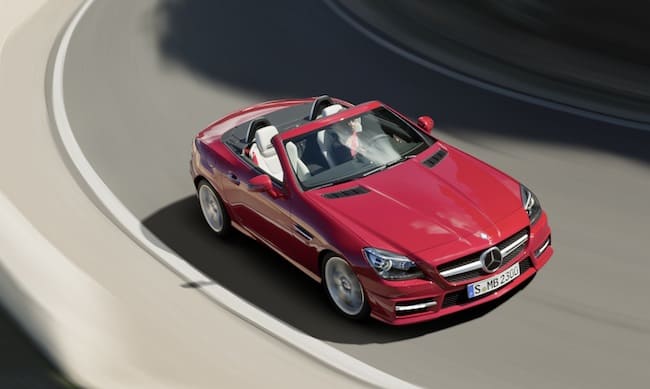Arona, Tenerife, Canary Islands — I’m treading on dangerous ground here, but the Mercedes-Benz SLK suffered through some awfully lean years, identity-wise, in the early days. This was back in 1996 when the little roadster first saw the light of day. Although it sold in droves and turned heads with its retractable hardtop roof—one of the very first in the history of this trickery—the SLK was also saddled with that most dreaded of automotive appellations: “chick car.”
This makes sense, though, right? A cute two-seater convertible of modest dimensions risks being thrown under the “chick car bus” no matter what its performance capabilities might be or which company is responsible for its production. Think: the Mazda Miata, Volkswagen Beetle, Volkswagen Golf, Volkswagen Eos…you get the picture.

Sales figures for the original SLK aside, this moniker effectively reduced its potential audience by, oh, about 50 per cent. The product planning mavens at Mercedes-Benz are no chimps; they recognized this fact and set about making the second-generation SLK, introduced in 2004, more muscular (in appearance) and more potent (in terms of performance). In other words, more appealing to those drivers who wouldn’t be caught dead driving a chick car.
The company’s most successful effort yet, in this observer’s humble opinion, was a slight variation of Gen 2, the 2009 model year SLK, the one with the racy facelift. This makeover visually linked the SLK to Mercedes’ reigning supercar of the time, the outrageous SLR, and upped the under-the-skin macho quotient all at once, particularly when the topic of conversation was the thundering SLK 55 AMG.
Now, there’s a brand new SLK coupe to consider, the third-generation example, and, confusingly, the chick-car designation is both more and less appropriate than ever before.
3 model choices

First, the SLK line encompasses three different models for the North American market: the 250, the 350, and the 55 AMG. Of these, the SLK 250 is the most interesting because it’s a new addition to the fleet and powered by an all-new engine.
The acronym “SLK” stands for three words in German: sportlich, leicht and kurz. Translated into the English, these words mean (roughly): sporty, light and short. As far as the SLK 250 is concerned, truer words were never spoken—in English or in German.
Under the hood

Powered by a 1.8-litre, 4-cylinder engine, the “littlest” SLK is also, arguably, the most compelling of the bunch. Reason being, said engine benefits from direct fuel injection and turbocharging to produce 201 horsepower and 229 lb-ft of torque in a comparatively lightweight package.
While the 250 is less powerful than the SLK 300 it replaces, it’s also more engaging; the steering is light but reassuringly precise, the stability control system now includes a feature that aids in cornering and the turbo engine produces a wildly entertaining growl-and-pop as you run through gears one through seven of the automatic transmission.
Although the SLK 250 can hardly be called quick, it could be considered “quick enough.” The sprint from naught to 100 km/h takes a leisurely (by sports car standards) seven seconds or so, but the Mercedes was seriously entertaining during a drive route that scaled El Teide, a volcanic mountain that dominates the sunny isle of Tenerife.

The last time I drove this route, I was piloting a Lamborghini Gallardo Spyder, a two-seater convertible that would never in a million miles be considered a chick car. It goes without saying that an exotic convertible armed with a 552-horsepower V10 would be more fun than a less-exotic convertible equipped with a 201-horsepower inline-4. Sure enough, the Lamborghini offered a more immediate and pulse-pounding experience, but my time with the SLK along those same roads had its own brand of appeal.
The Mercedes is a much smaller car, so it was better suited to the island’s incredibly narrow roads—just 1.25 lanes wide at times—and its turbocharged engine responded well as the drive route increased in elevation and the air got thinner.
The quick thinking continues with air deflectors built into the headrests to create a less buffeted ride and a vent system that blows hot air on your neck for those colder, top-down days.
Also, despite its even more aggressive design—the front of the new SLK now evokes the latest Mercedes supercar, the SLS—it has a relaxed vibe. The roaster can be engaging when it needs to be, when you keep your right foot pinned and take higher gears manually—and manfully!—using the paddle shifters. But you can also leave the centre console-mounted shifter well enough alone (once you throw it into “D”, of course) and let the Mercedes handle all the heavy lifting.
The SLK also impressed with innovations such as the optional “magic sky control” roof, a glass panel incorporated into the folding hardtop that lightens or darkens with the flick of a switch. The quick thinking continues with air deflectors built into the headrests to create a less buffeted ride and a vent system that blows hot air on your neck for those colder, top-down days.
Takeaway
Such thoughtful features give the 2012 Mercedes-Benz SLK 250 a very unique place in the market, one that it could not reach based on performance alone. It’s true: This roadster is not the fastest in the segment, nor is it the most exciting, but the SLK has enough going for it to merit consideration from those who like their time behind the wheel to be sporty and light, but maybe not so short. Prices for the SLK 250 start at $66,500.


